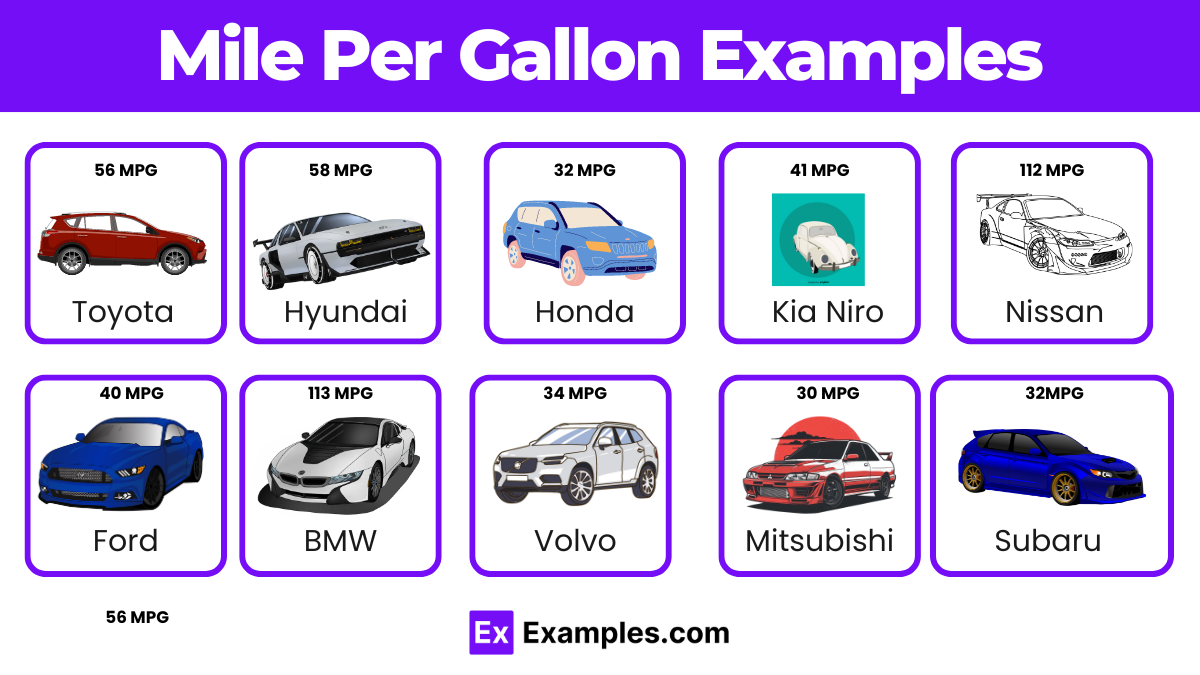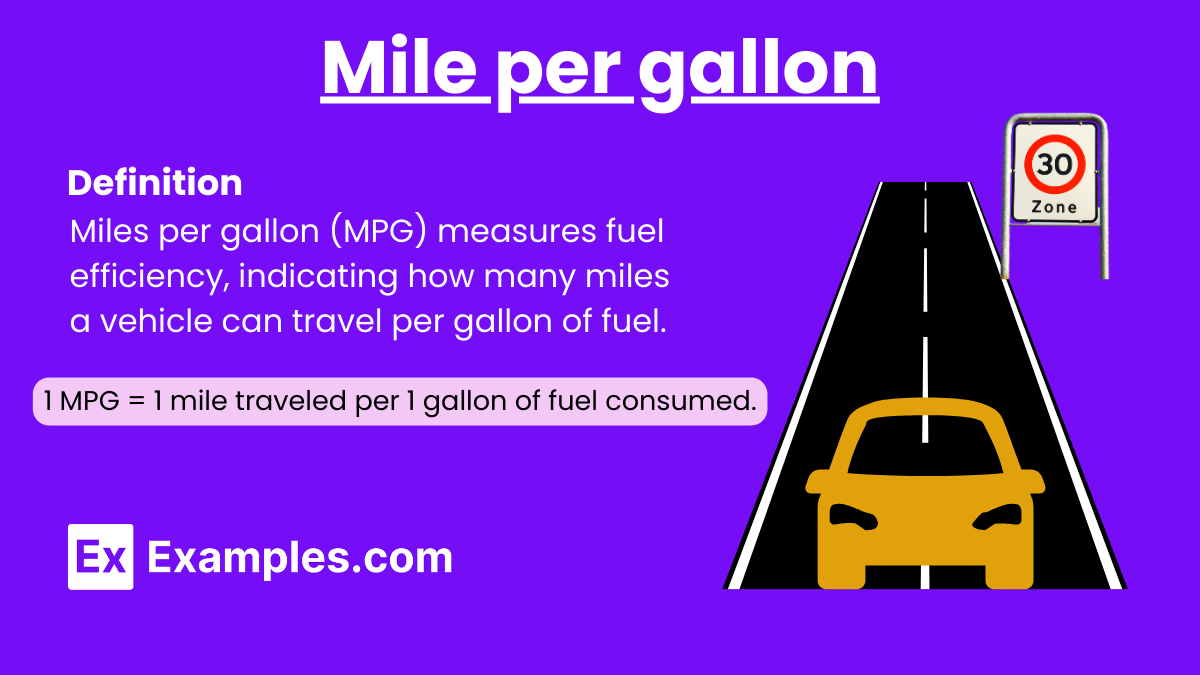21+ Mile per Gallon Examples to Download
Mile per Gallon (MPG) is a crucial measure of a vehicle’s fuel efficiency, indicating the distance a car can travel per gallon of fuel. It helps drivers and fleet managers monitor and optimize fuel consumption. Tracking MPG can be simplified with a printable mileage log, which allows for easy recording of miles driven and gallons used. This log helps in calculating MPG accurately, ensuring better fuel management and cost savings for both personal and business use.
What is Mile per Gallon?
Mile per Gallon (MPG) is a measurement of a vehicle’s fuel efficiency, indicating the number of miles it can travel using one gallon of fuel. It helps compare the fuel economy of different vehicles, essential for cost and environmental considerations.
Examples of Mile per Gallon

- Toyota Prius: 56 MPG
- Hyundai Ioniq: 58 MPG
- Honda Insight: 55 MPG
- Toyota Corolla Hybrid: 52 MPG
- Kia Niro: 50 MPG
- Hyundai Elantra Hybrid: 54 MPG
- Ford Escape Hybrid: 44 MPG
- Toyota Camry Hybrid: 52 MPG
- Honda Accord Hybrid: 48 MPG
- Lexus ES 300h: 44 MPG
- Chevrolet Malibu Hybrid: 46 MPG
- Nissan Altima: 32 MPG
- Ford Fusion Hybrid: 42 MPG
- Toyota RAV4 Hybrid: 40 MPG
- Lexus UX 250h: 39 MPG
- Subaru Crosstrek Hybrid: 35 MPG
- Hyundai Sonata Hybrid: 52 MPG
- Kia Optima Hybrid: 45 MPG
- BMW 330e: 75 MPGe (combined electric and gasoline)
- Toyota Avalon Hybrid: 44 MPG
- Volvo XC90 Hybrid: 27 MPG (combined electric and gasoline)
- Mitsubishi Outlander PHEV: 74 MPGe (combined electric and gasoline)
Mile Per Gallon Types
- City MPG – Fuel efficiency in urban driving with frequent stops and starts.
- Highway MPG – Fuel efficiency on highways with steady speeds.
- Combined MPG – Average of city and highway MPG.
- EPA Estimated MPG – Fuel efficiency estimated by the Environmental Protection Agency.
- Real-World MPG – Actual fuel efficiency experienced by drivers.
- Adjusted MPG – MPG adjusted for real-world conditions.
- Laboratory Test MPG – MPG determined under controlled lab conditions.
- Fleet MPG – Average fuel efficiency for a fleet of vehicles.
- Curb Weight MPG – MPG affected by the vehicle’s curb weight.
- Aerodynamic MPG – MPG influenced by a vehicle’s aerodynamics.
- Electric Hybrid MPG – Fuel efficiency of hybrid vehicles combining electric and gasoline power.
- Plug-in Hybrid MPG – MPG for plug-in hybrid vehicles considering electric range.
- Turbocharged Engine MPG – Fuel efficiency for vehicles with turbocharged engines.
- Eco Mode MPG – MPG when driving in a vehicle’s eco mode.
- Four-Wheel Drive MPG – Fuel efficiency for vehicles with four-wheel drive.
- Sport Mode MPG – MPG when driving in sport mode.
- Manual Transmission MPG – Fuel efficiency for vehicles with manual transmissions.
- Automatic Transmission MPG – Fuel efficiency for vehicles with automatic transmissions.
- Diesel MPG – Fuel efficiency for diesel-powered vehicles.
- Ethanol MPG – Fuel efficiency for vehicles using ethanol-blended fuels.
- High-Performance MPG – MPG for high-performance or sports cars.
- Off-Road MPG – Fuel efficiency for off-road driving conditions.
Miles Per Gallon to litres
- Start with MPG – Note the MPG value you want to convert.
- Convert MPG to km/L – Multiply the MPG value by 0.425144 to get kilometers per liter (km/L).
- Calculate L/100km – Divide 100 by the km/L value to convert to liters per 100 kilometers.
- Use the Formula – The formula for conversion is:
L/100km = 100/MPG × 0.425144100
- Verify with Measurement Chart – Use a measurement chart to verify your conversion for accuracy and quick reference.
- Document the Results – Record the converted values for future use or comparison.
Miles Per Gallon Formula
MPG = Miles Driven/Gallons of Fuel Used
Miles Per Gallon Diesel
- Higher Efficiency – Diesel engines typically offer better fuel efficiency compared to gasoline engines, resulting in higher MPG ratings.
- Fuel Density – Diesel fuel is denser than gasoline, providing more energy per gallon and contributing to higher MPG.
- Longer Range – Vehicles with diesel engines often have a longer driving range per tank due to higher MPG, as shown in MPG measurement charts..
- Heavy-Duty Use – Diesel engines are commonly used in heavy-duty vehicles like trucks and buses, where high MPG is essential for cost-effectiveness.
- Environmental Impact – Higher MPG in diesel vehicles can reduce fuel consumption and emissions, although diesel engines may produce more nitrogen oxides (NOx).
- Driving Conditions – Diesel MPG can vary based on driving conditions, load, terrain, and driving habits.
To calculate the MPG for a diesel vehicle, use the same formula as for gasoline:
MPG = Miles Driven/Gallons of Diesel Used
How Many Miles Per Gallon?
The fuel efficiency of a vehicle, measured in Miles Per Gallon (MPG), can vary widely based on several factors, including the type of vehicle, driving conditions, and maintenance. Here’s a general idea of the typical MPG ranges for different types of vehicles:
- Small Cars:
- City: 25-30 MPG
- Highway: 35-40 MPG
- Combined: 30-35 MPG
- Midsize Cars:
- City: 20-25 MPG
- Highway: 30-35 MPG
- Combined: 25-30 MPG
- Large Cars:
- City: 15-20 MPG
- Highway: 25-30 MPG
- Combined: 20-25 MPG
- SUVs (Compact):
- City: 20-25 MPG
- Highway: 25-30 MPG
- Combined: 22-27 MPG
- SUVs (Midsize and Large):
- City: 15-20 MPG
- Highway: 20-25 MPG
- Combined: 17-22 MPG
- Trucks (Light-Duty):
- City: 15-20 MPG
- Highway: 20-25 MPG
- Combined: 17-22 MPG
- Trucks (Heavy-Duty):
- City: 10-15 MPG
- Highway: 15-20 MPG
- Combined: 12-17 MPG
- Hybrid Vehicles:
- City: 40-60 MPG
- Highway: 35-50 MPG
- Combined: 40-55 MPG
- Electric Vehicles (Miles per Gallon Equivalent – MPGe):
- City: 80-120 MPGe
- Highway: 70-100 MPGe
- Combined: 75-110 MPGe
Factors Affecting MPG
- Driving Habits: Aggressive driving, frequent stops, and rapid acceleration can reduce MPG, the standard unit of measurement for fuel efficiency.
- Maintenance: Regular maintenance, such as keeping tires properly inflated and changing air filters, can improve MPG.
- Load and Terrain: Carrying heavy loads and driving in hilly or mountainous terrain can reduce MPG.
- Climate: Extreme temperatures and the use of air conditioning or heating can affect fuel efficiency.
How to Calculate Your Vehicle’s MPG
- Fill the Tank – Start with a full fuel tank.
- Reset the Odometer – Reset your trip odometer to zero.
- Drive Normally – Drive your vehicle as you typically would.
- Record Miles Driven – Note the number of miles driven from the trip odometer.
- Refill the Tank – Refill your tank to full again and record the gallons of fuel added.
- Use the Formula – Calculate the MPG using the formula:
Uses
- Vehicle Comparison : Consumers use the measurement chart of MPG to compare vehicles, aiding informed decisions on fuel-efficient car purchases, highlighted by dealerships and websites.
- Environmental Considerations : MPG is a critical factor for environmentally conscious consumers. Higher MPG vehicles typically emit fewer greenhouse gases and pollutants. This information can guide buyers toward greener choices, contributing to sustainability efforts.
- Fuel Economy Standards : Governments and regulatory bodies use MPG to set and enforce fuel economy standards. For example, the Corporate Average Fuel Economy (CAFE) standards in the United States require manufacturers to achieve a specific fleet-wide average MPG.
- Cost Calculation : Consumers use MPG to calculate their potential fuel expenses. By knowing a vehicle’s MPG, one can estimate the cost of fuel for a specific distance, aiding in budgeting and financial planning.
- Vehicle Maintenance and Performance Monitoring : MPG can indicate the health and performance of a vehicle. A sudden drop in MPG might signal issues such as poor engine performance, underinflated tires, or other mechanical problems.
- Fleet Management : Businesses with vehicle fleets, such as delivery services or transportation companies, use MPG to manage fuel costs and efficiency. By monitoring MPG, they can optimize routes, maintenance schedules, and vehicle choices to maximize fuel savings.
Average MPG Ratings for Common Vehicle Types
| Vehicle Type | City MPG | Highway MPG | Combined MPG |
|---|---|---|---|
| Compact Car | 25-30 | 35-40 | 28-35 |
| Mid-Size Car | 20-25 | 30-35 | 25-30 |
| Full-Size Car | 15-20 | 25-30 | 20-25 |
| Small SUV | 20-25 | 27-32 | 23-28 |
| Mid-Size SUV | 15-20 | 22-27 | 18-23 |
| Full-Size SUV | 12-17 | 18-23 | 14-19 |
| Pickup Truck (2WD) | 15-20 | 20-25 | 17-21 |
| Pickup Truck (4WD) | 13-18 | 18-22 | 15-20 |
| Minivan | 18-22 | 25-30 | 21-25 |
| Hybrid Car | 45-55 | 45-60 | 50-55 |
| Plug-in Hybrid Car | 70-90 (Electric + Gas) | 90-100 (Electric + Gas) | 80-95 (Electric + Gas) |
| Electric Vehicle (EV) | 100-120 (MPGe) | 120-150 (MPGe) | 110-135 (MPGe) |
How do you calculate MPG?
Divide the number of miles traveled by the gallons of fuel used.
Why is MPG important?
Higher MPG means better fuel efficiency, saving money and reducing environmental impact.
What is a good MPG?
Generally, 25-30 MPG is considered good for most vehicles.
How can I improve my vehicle’s MPG?
Maintain proper tire pressure, perform regular maintenance, and drive at steady speeds.
Does driving speed affect MPG?
Yes, higher speeds typically decrease MPG.
Does vehicle weight affect MPG?
Yes, heavier vehicles usually have lower MPG.
Do hybrid cars have better MPG?
Yes, hybrid cars generally have higher MPG due to their combination of gasoline and electric power.
What is the average MPG for a car?
The average MPG for a car in the US is about 25 MPG.
How does air conditioning affect MPG?
Using air conditioning can lower your MPG slightly.
Do electric vehicles have an MPG rating?
Electric vehicles have an MPGe rating, which measures their energy efficiency.



